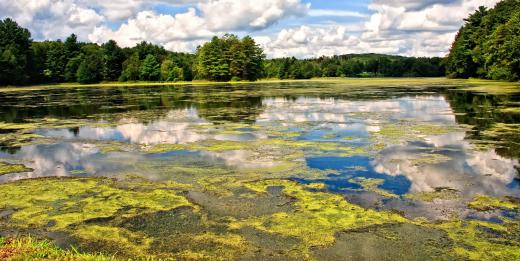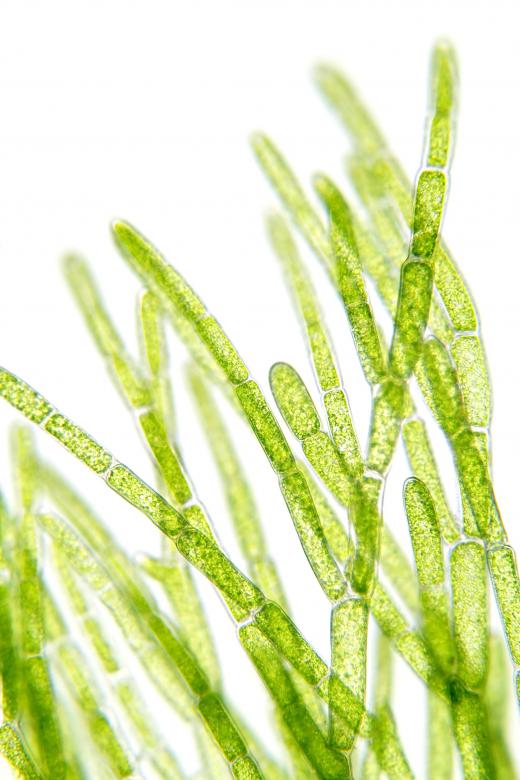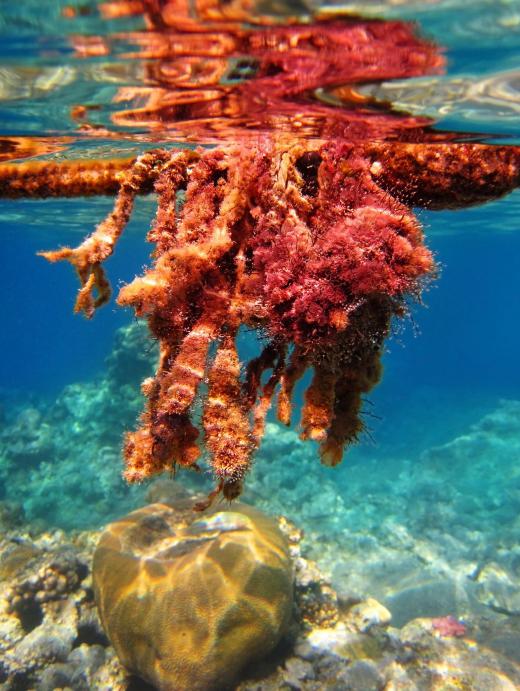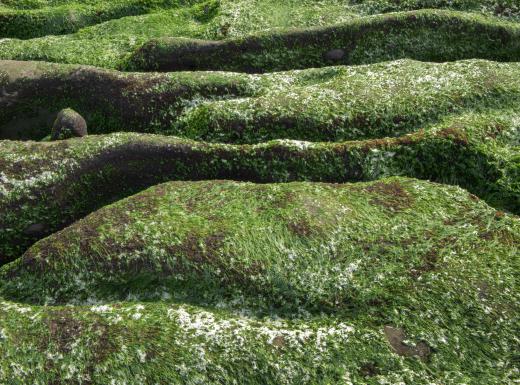What is Algae?
 Michael Anissimov
Michael Anissimov
Algae (singular alga) are a large group of diverse organisms that use photosynthesis to produce food. Although some forms are large and multicellular, they differ from plants in that their cells are not clearly organized into different types of tissue with different functions. This group includes a wide variety of organisms that are not always closely related to one another — the similarities in form are often due to parallel evolution, where different organisms have adapted in similar ways to fill similar niches. They are described as polyphyletic, meaning that not all members of the group share the same common ancestor.
By the modern definition, all algae are eukaryotes, which means that the DNA in their cells is contained within a nucleus enclosed by a membrane. Organisms whose cells do not have a nucleus are prokaryotes. The eukaryotes also include plants, fungi and animals. Prokaryotes include bacteria and archaea. The algae can be divided into a number of sub-groups, based largely on the types of pigments they use for photosynthesis.
Green Algae

These forms use the green pigment chlorophyll to photosynthesize, and they are thought to be the ancestors of land plants. Some authorities include them in the plant kingdom, while others prefer to regard them as a separate category of life. They may be single celled or multicellular, and some types live in colonies or form long filaments consisting of many cells. A number of the single-celled types are capable of independent movement using flagellae — long, whip-like structures used by many microorganisms for locomotion. Green algae are found in a wide variety of habitats, including freshwater, the sea, soil, tree trunks and damp walls, but the majority are aquatic.

It is thought that land plants evolved from a type of green alga, possibly about 500 million years ago. They contain the same types of chlorophyll and other pigments as land plants. There are further similarities: for example, the chlorophyll is contained in structures called chloroplasts, and many types store sugars in starch granules, as do land plants.
Red Algae

Also known as rhodophyta, these were among the first eukaryotic organisms on the planet, and their signatures have been found in rocks almost 2 billion years old. They are mostly marine organisms, and include many types of seaweed, as well as a number of single-celled species. Their red color comes from the pigments phycoerythrin and phycocyanin, which they use for photosynthesis. These pigments absorb blue light, which reaches further below the ocean surface than the red light trapped by chlorophyll, allowing the rhodophyta to photosynthesize at greater depths. This group also includes coralline algae, which build shells made of calcium carbonate for themselves and can form reefs.
Brown Algae

The proper scientific name for this group is chromista. It is an extremely diverse group, with its members ranging from diatoms — microscopic, single-celled forms with silica shells — to “kelp” seaweeds — large, multicellular organisms that can grow to 164 feet (50 meters) in length. They use a different kind of chlorophyll from that used by plants to photosynthesize and often have additional pigments, such as fucoxanthin, which gives many of these organisms a brown color. Diatoms are an important part of the phytoplankton, which produce a great deal of the planet’s oxygen through photosynthesis and form the base of many marine food chains. Kelp seaweeds can form extensive seafloor “forests,” which are of great ecological importance.
Cyanobacteria
Today, these microorganisms are considered to be bacteria; however, they are still sometimes referred to by their old name, “blue-green algae.” They differ mainly in that they are prokaryotes, like all bacteria, but they can make their own food by photosynthesis. Cyanobacteria are a very ancient group and may have been the very first organisms to use photosynthesis. Many experts think that, in the distant past, some single-celled, non-photosynthesizing organisms may have incorporated cyanobacteria in a symbiotic relationship, and that these bacteria may have become the chloroplasts that are seen today in algae and plants.
Algal Blooms
From time to time, in certain locations, a species of alga may undergo a population explosion, resulting in what is known as an “algal bloom.” These can occur on coastlines and in freshwater lakes. It is not always possible to establish the cause, but often, it seems to be due to agricultural run-off containing fertilizers that stimulate increased growth and multiplication. Algal blooms are often harmful to other aquatic life forms, and occasionally to animals and even humans. The huge numbers of algae can severely reduce the oxygen content of the water, and some species produce toxins that can kill or harm other organisms.
Uses
A number of types of seaweed, especially among the red algae, can be eaten. Seaweeds also provide a number of important food additives, and agar — a type of gel used for culturing microorganisms. Another potential use is in the production of biofuels. The organisms are fast growing and undemanding in terms of conditions and nutritional requirements, and so they can provide a cheap and efficient way of accumulating biomass for fuel.
AS FEATURED ON:
AS FEATURED ON:














Discussion Comments
Since they are photosynthetic animals, they trap ultraviolet heat from the sun.
@anon252214 – I've never heard of algae growing in forests of trees, but there is something called an algae forest. It grows in the sea, though.
In Antarctica, there is a giant underwater forest of algae. Researchers have been studying the algae as a possible treatment for cancer.
Wouldn't it be awesome if something as plentiful and as seemingly useless as algae could be the solution to the biggest health problem ever? It would be such a simple answer to questions that have stumped the medical community for decades.
I grew up next to a cow pasture with a small pond in it. Whenever the cows were far on the other side of the pasture, I would go out to the pond and explore.
I had gotten a microscope for my ninth birthday, and I desperately wanted to get a sample of the pond algae and put it on a slide. Since the stuff was alive, I just knew I could see some movement.
What I saw was really creepy. It looked like a baby octopus moving its legs around!
@anon13235 – Algae gives us oxygen. In fact, it gives us more oxygen than other plants do.
I read that algae makes about 75% of the total oxygen on earth. It's hard to believe that little patches of slime that we see as a nuisance are so vital to our existence.
Algae does feel really gross. It has the consistency of mucus. It's amazing that something so matted and gooey can produce oxygen!
You can get really sick from blue-green algae, and so can your animals. I remember a few years ago during a really hot summer when there was a big algae bloom in my area. Newscasters warned people not to get in the ponds and to keep their animals from swimming in them or drinking from them.
There have been cases where farmers have lost livestock because they drank the algae. It has to be more than just a little algae, though. There has to be a big bloom of it in order for it to be really dangerous.
Does algae grow in forests?
what is algae all together, not just green algae and red algae ?
what does algae eat and what does it do?
algae that grow on top of the pond is not good because they block the sunlight that the plants need.
please, anyone can help me in my project? What does algae look like?
does the algae do anything important to us?
i need to do an assignment on snails and slugs! help!
hey i need to know what algae would look like for a project i have. can anyone help?
why are lichen important?
Differentiate lichens from algae and fungi.
We need algae for oxygen; believe it or not, algae contains 50% of our oxygen! That's why we need algae!
how would a gene mutation affect the algae and how important is vitamin B 12
For those who can not eat fish, algae is another source of omega 3 fatty acids that can be added to one's diet.
why do we have algae? what does it do for us, and why do we need it in our environment ???? any feedback welcome, thanks. lorna.
Post your comments